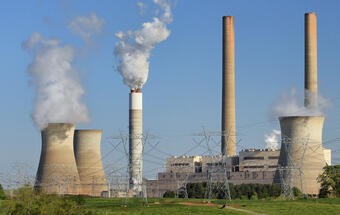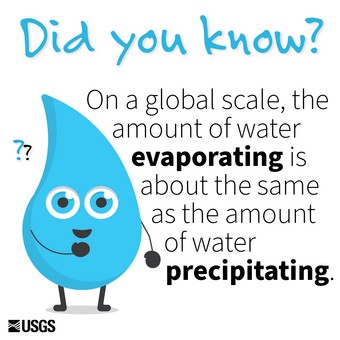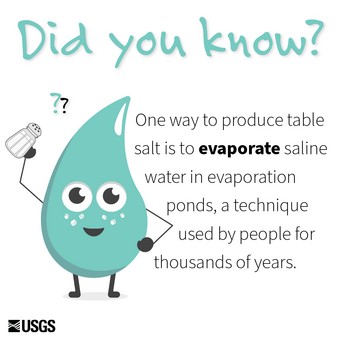Evaporation is a crucial process where liquid water transforms into gaseous water, also known as water vapor, playing a vital role in the water cycle. This transformation, driven by heat, moves water from Earth’s surface into the atmosphere, impacting weather patterns and climate. Learn about the science behind evaporation, its importance in the water cycle, and how humans utilize this natural phenomenon; discover more about phase transition, latent heat, and vaporization.
1. What Is Evaporation and Why Does It Occur?
Evaporation is the phase transition process that changes liquid water into gaseous water (water vapor). It’s how water moves from Earth’s surface – oceans, lakes, rivers, and even moist soil – into the atmosphere, becoming an integral part of the Earth’s water cycle. WHAT.EDU.VN is here to help you understand this fascinating process.
Evaporation happens when enough energy, typically in the form of heat, overcomes the intermolecular forces holding water molecules together. Imagine you’re heating water on a stove. The heat you add increases the kinetic energy of the water molecules. When these molecules gain enough energy, they break free from the liquid state and become a gas, which we see as steam. Water reaches its boiling point at 212°F (100°C), it evaporates rapidly, but it can also evaporate more slowly even at its freezing point, albeit at a much slower pace, as long as there’s sufficient energy available.
The opposite of evaporation is condensation, where water vapor turns back into liquid water. This occurs when air saturated with water vapor cools, causing the water molecules to slow down and clump together, forming liquid droplets. You can see this on a cold glass of water on a humid day.
2. How Does Evaporation Drive the Water Cycle?
Evaporation is a driving force behind the water cycle. It’s responsible for the majority of moisture in the atmosphere, with about 90% originating from evaporation from oceans, seas, lakes, and rivers. Given that over 70% of the Earth’s surface is covered by oceans, they are the primary contributors to the overall volume of water evaporating into the atmosphere. The remaining moisture comes from plant transpiration and, to a much lesser extent, sublimation (the process of ice turning directly into vapor).
Globally, the amount of water evaporating roughly balances the amount of water falling back to Earth as precipitation. However, this balance varies geographically. Evaporation is more common over the oceans than precipitation, while over land, precipitation often exceeds evaporation. Most of the water that evaporates from the oceans falls back into the oceans as precipitation. Only about 10% of the water evaporated from the oceans is transported over land and falls as precipitation. Once evaporated, a water molecule typically spends about 10 days in the air.
The process of evaporation is so significant that without precipitation, runoff, and groundwater discharge from aquifers, oceans would become nearly empty over time. This constant cycle of evaporation and precipitation is essential for maintaining the Earth’s water balance and supporting life.
3. What Factors Influence the Rate of Evaporation?
Several factors influence how quickly evaporation occurs. Understanding these factors helps us predict and manage water resources more effectively.
- Temperature: Higher temperatures provide more energy to water molecules, increasing their kinetic energy and making it easier for them to break free from the liquid state.
- Humidity: Lower humidity means the air can hold more water vapor. When the air is already saturated (high humidity), evaporation slows down because there’s less capacity for additional water vapor.
- Wind Speed: Wind removes water vapor from the surface, reducing humidity and allowing more evaporation to occur.
- Surface Area: A larger surface area allows more water molecules to be exposed to the air, increasing the rate of evaporation.
- Air Pressure: Lower air pressure reduces the force holding water molecules in the liquid state, making it easier for them to evaporate.
- Water Quality: The presence of solutes (dissolved substances) in the water can affect evaporation rates. For example, saltwater evaporates slower than freshwater because the salt molecules interfere with the water molecules’ ability to escape into the air.
4. How Do Humans Make Use of Evaporation?
Humans have harnessed evaporation for various purposes throughout history. Understanding and utilizing this natural process has led to many practical applications.
- Salt Production: One of the oldest uses of evaporation is producing salt. Saline water is evaporated in ponds, leaving behind salt crystals. This technique has been used for thousands of years to obtain table salt and other minerals.
- Mineral Extraction: Seawater and water from mineral-rich sources like the Dead Sea are evaporated to extract valuable minerals such as magnesium, potash, and bromine. The Dead Sea, with its high salinity, is particularly ideal for this process.
- Cooling Systems: Evaporation is used in cooling towers at power plants to dissipate waste heat. Hot water is sprayed inside the towers, and evaporation cools the water before it’s released back into the environment.
- Evaporative Coolers: In dry climates, evaporative coolers (also known as swamp coolers) are used to lower air temperature. These devices pass dry, hot air through a wet pad, causing the water to evaporate and cool the air.
- Drying and Preservation: Evaporation is used to dry foods, preserving them by reducing the water content and inhibiting microbial growth. Examples include sun-dried tomatoes and dehydrated fruits.
- Wastewater Treatment: Evaporation ponds are used to reduce the volume of wastewater by allowing water to evaporate, concentrating the remaining pollutants for easier disposal.
5. What Is Evaporative Cooling, and How Does It Work?
Evaporative cooling is a natural process that uses evaporation to lower the temperature of an object or space. It works because evaporation requires energy, which is drawn from the surrounding environment in the form of heat.
When water evaporates, it absorbs heat from the air, reducing the air temperature. This is why you feel cooler after stepping out of a shower or when a physician wipes your arm with an alcohol pad before an injection. The rapid evaporation of the water or alcohol removes heat from your skin, creating a cooling sensation.
Evaporative coolers are designed to maximize this effect. They draw in hot, dry air and pass it through a wet pad. As the water in the pad evaporates, it cools the air, which is then circulated into a room or building. Evaporative coolers are most effective in climates with low humidity, where the air can absorb more water vapor.
6. What Are the Environmental Impacts of Evaporation?
Evaporation is a natural process, but human activities can influence its rate and impact the environment.
- Water Scarcity: Increased evaporation due to climate change can exacerbate water scarcity in already dry regions. Higher temperatures lead to more evaporation from lakes, rivers, and soil, reducing water availability for agriculture, industry, and human consumption.
- Salinization: In irrigated areas, evaporation can lead to salinization, where salts accumulate in the soil. As water evaporates from the soil surface, it leaves behind dissolved salts, making the land less fertile over time.
- Changes in Precipitation Patterns: Altered evaporation rates can affect precipitation patterns, leading to droughts in some areas and increased rainfall in others. Changes in land use, such as deforestation, can also influence local evaporation rates and regional climate.
- Impact on Aquatic Ecosystems: Increased evaporation from lakes and rivers can reduce water levels, impacting aquatic ecosystems and threatening the survival of fish and other aquatic organisms.
- Greenhouse Gas Emissions: While evaporation itself doesn’t directly emit greenhouse gases, the energy used to power processes that involve evaporation, such as industrial cooling, can contribute to emissions if the energy source is fossil fuels.
7. How Is Evaporation Measured?
Measuring evaporation is essential for understanding water balance, managing water resources, and predicting weather patterns. Several methods are used to measure evaporation, each with its own advantages and limitations.
- Evaporation Pans: Evaporation pans are simple devices used to measure the amount of water that evaporates from an open surface over a specific period. A standard pan is typically a circular metal container filled with water. The water level is measured daily, and the difference between the initial and final levels indicates the amount of evaporation.
- Lysimeters: Lysimeters are more sophisticated devices that measure the water balance of a soil column, including evaporation, precipitation, and drainage. They are used to study the effects of different land uses and management practices on evaporation rates.
- Eddy Covariance: Eddy covariance is a micrometeorological technique that measures the vertical fluxes of water vapor and other gases between the surface and the atmosphere. It provides continuous, real-time measurements of evaporation rates over large areas.
- Remote Sensing: Remote sensing techniques, such as satellite imagery, can be used to estimate evaporation rates over large areas. These methods rely on measuring surface temperature, vegetation cover, and other factors that influence evaporation.
- Water Balance Method: The water balance method calculates evaporation as the difference between precipitation, inflow, and outflow in a given area. This method is commonly used to estimate evaporation from lakes, reservoirs, and watersheds.
8. What Is the Difference Between Evaporation and Boiling?
While both evaporation and boiling involve the phase transition from liquid to gas, they are distinct processes with key differences.
- Evaporation: Occurs at the surface of a liquid and can happen at any temperature below the boiling point. It is a slower process that depends on factors like humidity, wind speed, and surface area.
- Boiling: Occurs throughout the entire volume of a liquid and happens only at the boiling point. It is a much faster process that requires a specific temperature and the formation of bubbles within the liquid.
In simpler terms, evaporation is a surface phenomenon, while boiling is a bulk phenomenon. Evaporation is a gradual process, while boiling is a rapid and vigorous one.
9. What Role Does Evaporation Play in Climate Change?
Evaporation plays a significant role in climate change, both as a driver and a consequence.
- Increased Evaporation: As global temperatures rise due to climate change, evaporation rates increase. This leads to drier conditions in many regions, exacerbating droughts and increasing the risk of wildfires.
- Changes in Humidity: Increased evaporation can lead to higher humidity in some areas, which can intensify heat waves and make them more dangerous. Higher humidity also affects precipitation patterns, leading to more intense rainfall in some regions and less in others.
- Feedback Loops: Evaporation can create feedback loops that amplify climate change. For example, as ice and snow melt due to warming temperatures, more dark surfaces are exposed, which absorb more sunlight and increase evaporation, leading to further warming.
- Impact on Water Resources: Changes in evaporation rates can have significant impacts on water resources. Increased evaporation from lakes and rivers can reduce water availability for human use and harm aquatic ecosystems.
10. Common Misconceptions About Evaporation
There are several common misconceptions about evaporation that can lead to misunderstandings about this important process.
- Evaporation Only Occurs at High Temperatures: While higher temperatures increase evaporation rates, evaporation can occur at any temperature below the boiling point. Even ice can evaporate through a process called sublimation.
- Evaporation and Boiling Are the Same Thing: As mentioned earlier, evaporation and boiling are distinct processes. Evaporation occurs at the surface of a liquid at any temperature, while boiling occurs throughout the entire volume of a liquid at the boiling point.
- Evaporation Is Always Beneficial: While evaporation is a natural and essential process, it can have negative impacts in certain situations, such as contributing to water scarcity and salinization.
- Evaporation Is a Simple Process: Evaporation is influenced by a complex interplay of factors, including temperature, humidity, wind speed, surface area, and air pressure. Understanding these factors is essential for accurately predicting and managing evaporation rates.
FAQ About Evaporation
| Question | Answer |
|---|---|
| What is the role of evaporation in the water cycle? | Evaporation is a key process in the water cycle, transferring water from the Earth’s surface to the atmosphere as water vapor, contributing to cloud formation and precipitation. |
| How does temperature affect evaporation? | Higher temperatures increase the kinetic energy of water molecules, making it easier for them to escape into the atmosphere, thus accelerating the evaporation process. |
| What is the difference between evaporation and vaporization? | Vaporization is a broader term that includes both evaporation and boiling. Evaporation occurs at the surface of a liquid at any temperature, while boiling occurs throughout the entire volume of a liquid at the boiling point. |
| Can evaporation occur in a vacuum? | Yes, evaporation can occur in a vacuum. In a vacuum, there is no air pressure to hold the water molecules in the liquid state, so they can more easily escape into the gaseous state. |
| What are some practical applications of evaporation? | Evaporation is used in various applications, including salt production, cooling systems, drying and preservation of foods, and wastewater treatment. |
| What is the impact of climate change on evaporation? | Climate change is causing increased evaporation rates in many regions, leading to drier conditions, water scarcity, and changes in precipitation patterns. |
| How does humidity affect evaporation? | Higher humidity means the air is already saturated with water vapor, reducing the capacity for additional water vapor and slowing down the evaporation process. |
| What is evaporative cooling? | Evaporative cooling is a process that uses evaporation to lower the temperature of an object or space. It works by absorbing heat from the surrounding environment as water evaporates. |
| How is evaporation measured? | Evaporation is measured using various methods, including evaporation pans, lysimeters, eddy covariance, remote sensing, and the water balance method. |
| What is the relationship between evaporation and condensation? | Evaporation and condensation are opposite processes. Evaporation is the process of liquid water turning into water vapor, while condensation is the process of water vapor turning back into liquid water. |



Still Have Questions About Evaporation? Ask WHAT.EDU.VN!
We understand that finding answers to your questions can be challenging and time-consuming. You might not know who to ask or where to look for reliable information. Searching through countless websites and articles can be overwhelming, and you might still not find the answers you need. Moreover, professional consultations can be costly.
But now, there’s a solution. At WHAT.EDU.VN, we provide a free platform where you can ask any question and receive quick, accurate answers from knowledgeable individuals. Whether you’re a student, a professional, or simply a curious mind, our platform is designed to connect you with the information you seek.
Here’s how WHAT.EDU.VN solves your challenges:
- Free Access: Ask any question without worrying about consultation fees.
- Quick Responses: Get answers promptly, saving you valuable time.
- Reliable Information: Receive answers from knowledgeable members.
- Easy to Use: Our platform is designed for ease of use, making it simple to ask questions and receive answers.
- Community Support: Connect with a community of learners and experts, fostering a collaborative environment.
Ready to get your questions answered? Visit WHAT.EDU.VN today and experience the convenience of free, fast, and reliable answers.
Contact Us:
- Address: 888 Question City Plaza, Seattle, WA 98101, United States
- WhatsApp: +1 (206) 555-7890
- Website: WHAT.EDU.VN
Don’t let your questions go unanswered. Join what.edu.vn and start exploring the world of knowledge today!